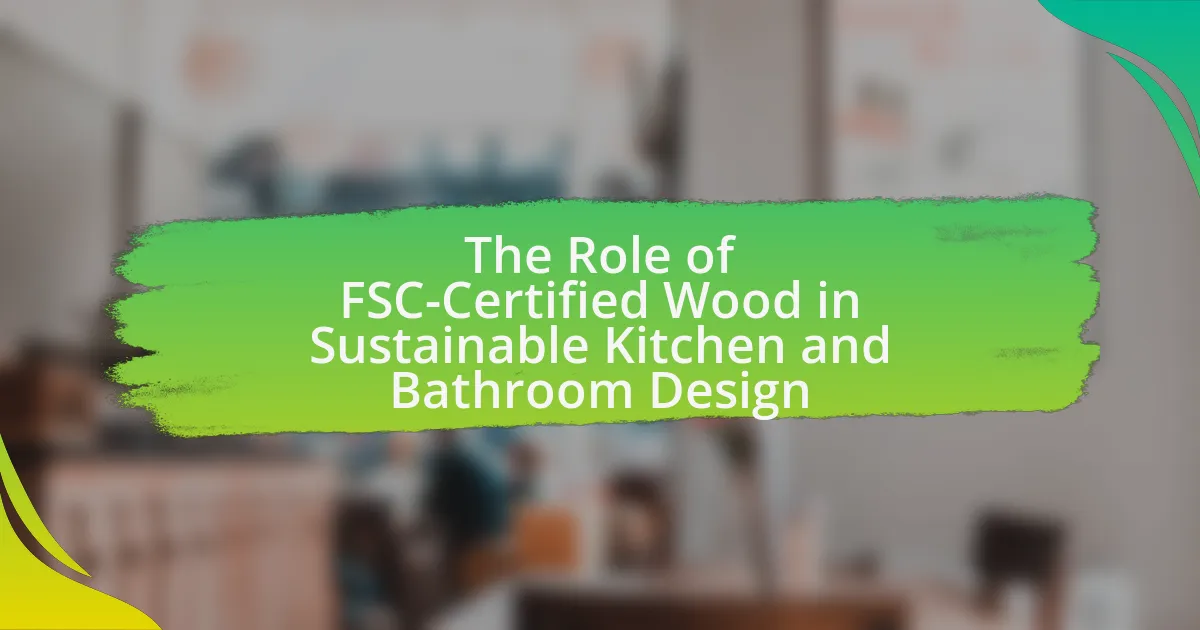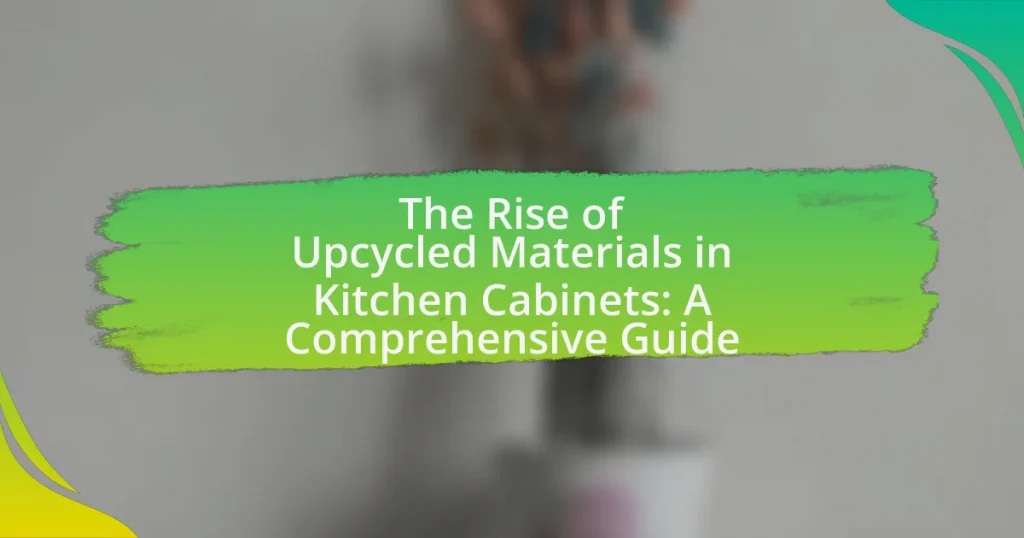FSC-Certified Wood refers to timber sourced from forests managed according to strict environmental, social, and economic standards established by the Forest Stewardship Council (FSC). This article explores the significance of FSC-certified wood in sustainable kitchen and bathroom design, highlighting its role in promoting responsible forestry practices, reducing deforestation, and supporting biodiversity. It details the certification process, the criteria for achieving FSC certification, and the environmental benefits associated with using such wood. Additionally, the article examines the aesthetic and functional advantages of FSC-certified wood in kitchen and bathroom applications, the challenges of sourcing it, and best practices for incorporating it into design projects.
What is FSC-Certified Wood and its Importance in Sustainable Design?
FSC-Certified Wood is timber that has been sourced from forests managed according to strict environmental, social, and economic standards set by the Forest Stewardship Council (FSC). This certification ensures that the wood comes from responsibly managed forests that provide environmental, social, and economic benefits. The importance of FSC-Certified Wood in sustainable design lies in its ability to promote responsible forestry practices, reduce deforestation, and support biodiversity. By using FSC-Certified Wood, designers and builders contribute to sustainable development, ensuring that future generations can also benefit from forest resources.
How is FSC certification achieved?
FSC certification is achieved through a rigorous process that involves meeting specific environmental, social, and economic standards set by the Forest Stewardship Council. Organizations seeking certification must undergo an assessment by an accredited certification body, which evaluates their practices against the FSC’s criteria for responsible forest management. This includes ensuring that the wood is sourced from forests that are managed sustainably, protecting biodiversity, and respecting the rights of local communities. The certification process also requires ongoing compliance and periodic audits to maintain the certification status, ensuring continuous adherence to FSC standards.
What criteria must be met for wood to be FSC certified?
Wood must meet specific criteria to be FSC certified, including adherence to sustainable forest management practices, protection of biodiversity, and respect for the rights of indigenous peoples. The Forest Stewardship Council (FSC) requires that forests are managed in a way that maintains their ecological functions and integrity, ensuring that harvesting does not exceed the forest’s capacity to regenerate. Additionally, the certification process mandates compliance with legal regulations and the implementation of a management plan that addresses social, economic, and environmental aspects. These criteria are designed to promote responsible forestry and ensure that wood products are sourced from well-managed forests.
How does the certification process ensure sustainability?
The certification process ensures sustainability by establishing rigorous standards that promote responsible forest management and conservation. These standards require adherence to practices that protect biodiversity, prevent deforestation, and support the rights of local communities. For instance, the Forest Stewardship Council (FSC) certification mandates that forests are managed in a way that maintains their ecological functions and services, ensuring that wood products are sourced sustainably. This is evidenced by the fact that FSC-certified forests must meet criteria that include maintaining high conservation values and implementing measures to mitigate environmental impacts, thereby reinforcing the commitment to sustainability in the wood supply chain.
Why is FSC-certified wood preferred in kitchen and bathroom design?
FSC-certified wood is preferred in kitchen and bathroom design due to its sustainable sourcing and environmental benefits. This certification ensures that the wood comes from responsibly managed forests that provide environmental, social, and economic benefits. According to the Forest Stewardship Council, FSC-certified forests are managed to protect biodiversity, water resources, and the rights of indigenous peoples, making it a responsible choice for eco-conscious consumers. Additionally, using FSC-certified wood can contribute to LEED certification for green building projects, further enhancing its appeal in sustainable design.
What environmental benefits does FSC-certified wood provide?
FSC-certified wood provides significant environmental benefits, including the promotion of sustainable forest management and the preservation of biodiversity. By adhering to strict standards set by the Forest Stewardship Council, FSC-certified wood ensures that forests are managed responsibly, which helps maintain ecosystem balance and reduces deforestation rates. Studies indicate that FSC certification leads to improved forest health, as it prohibits clear-cutting and encourages practices that protect wildlife habitats. Additionally, FSC-certified wood contributes to carbon sequestration, as sustainably managed forests absorb carbon dioxide, mitigating climate change effects.
How does using FSC-certified wood contribute to healthier indoor environments?
Using FSC-certified wood contributes to healthier indoor environments by ensuring that the wood is sourced from responsibly managed forests, which reduces the release of harmful chemicals and promotes better air quality. FSC certification guarantees that the wood is harvested in a way that maintains biodiversity and ecosystem health, minimizing the impact on the environment. Additionally, products made from FSC-certified wood often contain fewer volatile organic compounds (VOCs), which are known to contribute to indoor air pollution and can cause health issues. Studies have shown that using materials with lower VOC emissions can significantly improve indoor air quality, making spaces safer and more comfortable for occupants.
How does FSC-Certified Wood Impact Kitchen Design?
FSC-Certified wood significantly impacts kitchen design by ensuring that the materials used are sourced sustainably, promoting environmental responsibility. This certification guarantees that the wood comes from forests that are managed to meet social, economic, and ecological needs, which aligns with the growing consumer demand for eco-friendly products. Additionally, using FSC-Certified wood can enhance the aesthetic appeal of kitchens, as it often features unique grain patterns and colors, contributing to a more natural and inviting atmosphere. The incorporation of such materials can also increase the overall value of the kitchen, as sustainable design is increasingly recognized as a desirable feature in home renovations.
What are the design advantages of using FSC-certified wood in kitchens?
FSC-certified wood offers several design advantages in kitchens, primarily due to its sustainability and aesthetic appeal. The use of FSC-certified wood ensures that the material comes from responsibly managed forests, which enhances the environmental integrity of kitchen designs. This certification often results in high-quality wood that is durable and visually appealing, allowing for a variety of design styles, from rustic to modern. Additionally, incorporating FSC-certified wood can contribute to LEED certification points for green building, making it an attractive choice for environmentally conscious homeowners and designers. The combination of sustainability, quality, and versatility in design makes FSC-certified wood a preferred option in contemporary kitchen design.
How does FSC-certified wood enhance aesthetic appeal in kitchen spaces?
FSC-certified wood enhances aesthetic appeal in kitchen spaces by providing a natural, warm look that complements various design styles. The certification ensures that the wood comes from responsibly managed forests, which often results in higher quality materials with unique grain patterns and colors. This quality not only adds visual interest but also contributes to a sense of authenticity and sustainability in the kitchen environment. Additionally, the use of FSC-certified wood can increase the overall value of the kitchen, as it aligns with eco-friendly trends that many homeowners prioritize.
What functional benefits does FSC-certified wood offer in kitchen applications?
FSC-certified wood offers several functional benefits in kitchen applications, including durability, moisture resistance, and aesthetic appeal. The certification ensures that the wood comes from responsibly managed forests, which contributes to its strength and longevity, making it suitable for high-use areas like kitchens. Additionally, FSC-certified wood is often treated to enhance its resistance to moisture and heat, reducing the risk of warping or damage from spills and humidity. The natural beauty of FSC-certified wood also enhances the visual appeal of kitchen spaces, providing a warm and inviting atmosphere.
What types of FSC-certified wood are commonly used in kitchen design?
FSC-certified wood commonly used in kitchen design includes maple, oak, cherry, and birch. These hardwoods are favored for their durability, aesthetic appeal, and sustainability, as they are sourced from responsibly managed forests. Maple is known for its fine grain and resistance to wear, making it ideal for cabinetry. Oak offers strength and a classic look, while cherry provides a rich color that deepens over time. Birch is appreciated for its smooth finish and versatility in design. The use of these woods supports sustainable practices, as they are certified by the Forest Stewardship Council, ensuring that they meet strict environmental and social standards.
Which species of wood are most popular for kitchen cabinetry?
The most popular species of wood for kitchen cabinetry include maple, oak, cherry, and hickory. Maple is favored for its durability and smooth grain, making it ideal for a variety of finishes. Oak is known for its strength and prominent grain patterns, which add character to cabinetry. Cherry wood is appreciated for its rich color and ability to darken with age, providing a timeless look. Hickory is valued for its unique grain and exceptional hardness, making it a robust choice. These species are commonly selected due to their aesthetic appeal, durability, and suitability for various design styles in kitchen cabinetry.
How do different finishes affect the performance of FSC-certified wood in kitchens?
Different finishes significantly impact the performance of FSC-certified wood in kitchens by enhancing durability, moisture resistance, and aesthetic appeal. For instance, oil-based finishes penetrate the wood, providing a natural look while offering protection against water and stains, which is crucial in a kitchen environment. Conversely, polyurethane finishes create a hard, protective layer on the surface, making the wood more resistant to scratches and heat, thus prolonging its lifespan. Research indicates that finishes like lacquer and varnish can also improve the wood’s resistance to microbial growth, which is essential for maintaining hygiene in kitchen settings. Therefore, the choice of finish directly influences the wood’s functionality and longevity in kitchen applications.
What Role Does FSC-Certified Wood Play in Bathroom Design?
FSC-certified wood plays a crucial role in bathroom design by ensuring that the materials used are sourced sustainably and responsibly. This certification indicates that the wood comes from forests that are managed according to strict environmental and social standards, which helps to reduce deforestation and promote biodiversity. Using FSC-certified wood in bathroom design not only enhances the aesthetic appeal with natural textures and finishes but also contributes to a healthier indoor environment by minimizing harmful chemicals often found in non-certified materials. Furthermore, the use of such wood aligns with the growing consumer demand for eco-friendly products, making it a valuable choice for designers aiming to create sustainable spaces.
How does FSC-certified wood contribute to moisture resistance in bathrooms?
FSC-certified wood contributes to moisture resistance in bathrooms primarily through its sustainable sourcing and treatment processes. This wood is harvested from responsibly managed forests, which often include species that naturally possess higher resistance to moisture and decay. Additionally, FSC-certified wood is typically treated with protective finishes that enhance its durability against humidity and water exposure. Studies indicate that certain types of FSC-certified wood, such as teak and cedar, have inherent oils and compounds that further improve their moisture resistance, making them suitable for bathroom environments where humidity levels are elevated.
What treatments can enhance the durability of FSC-certified wood in wet environments?
Treatments that can enhance the durability of FSC-certified wood in wet environments include pressure treatment with preservatives, application of water-repellent coatings, and the use of natural oils. Pressure treatment involves infusing wood with chemical preservatives that protect against decay and insect damage, significantly extending its lifespan in moist conditions. Water-repellent coatings create a barrier that prevents moisture absorption, reducing the risk of warping and fungal growth. Natural oils, such as tung or linseed oil, penetrate the wood and provide a protective layer that enhances water resistance while allowing the wood to breathe. These treatments are supported by studies indicating that treated wood can last significantly longer in wet environments compared to untreated wood, making them effective solutions for sustainable design in kitchens and bathrooms.
How does the choice of wood species affect moisture resistance in bathrooms?
The choice of wood species significantly affects moisture resistance in bathrooms, as different species have varying levels of natural oils and density that influence their ability to withstand humidity. For instance, teak and cedar are known for their high moisture resistance due to their natural oils that repel water, making them suitable for bathroom environments. In contrast, softer woods like pine are more susceptible to warping and decay when exposed to moisture. Studies indicate that using hardwoods with higher density, such as oak or mahogany, can also enhance durability and resistance to moisture-related damage. Therefore, selecting the appropriate wood species is crucial for maintaining the integrity and longevity of bathroom fixtures and furnishings.
What are the aesthetic considerations for using FSC-certified wood in bathrooms?
FSC-certified wood enhances the aesthetic appeal of bathrooms through its natural beauty, warmth, and variety of finishes. The unique grain patterns and colors of FSC-certified wood can complement various design styles, from rustic to modern, creating a visually pleasing environment. Additionally, using sustainably sourced wood aligns with eco-friendly design principles, appealing to environmentally conscious consumers. The certification ensures that the wood comes from responsibly managed forests, which can also add a story and authenticity to the design, further enhancing its aesthetic value.
How can FSC-certified wood complement various bathroom styles?
FSC-certified wood can complement various bathroom styles by providing a sustainable and aesthetically pleasing material that enhances both modern and traditional designs. Its natural grain and texture add warmth and elegance, making it suitable for minimalist, rustic, or contemporary themes. For instance, in a modern bathroom, the sleek finish of FSC-certified wood can create a clean and sophisticated look, while in a rustic setting, its organic appearance can evoke a cozy, natural ambiance. The versatility of FSC-certified wood allows it to be used in cabinetry, vanities, and accents, seamlessly integrating into diverse design schemes while promoting environmental responsibility.
What design elements can be enhanced with FSC-certified wood in bathrooms?
FSC-certified wood can enhance various design elements in bathrooms, including cabinetry, shelving, vanities, and accent features. The use of FSC-certified wood ensures that these elements are sourced sustainably, contributing to environmental conservation while providing aesthetic appeal. For instance, cabinetry made from FSC-certified wood offers durability and a natural look, which can elevate the overall design of the bathroom. Additionally, incorporating shelving and vanities crafted from this wood can create a warm and inviting atmosphere, aligning with modern sustainable design principles.
What are the Challenges and Solutions in Using FSC-Certified Wood?
The challenges in using FSC-certified wood include higher costs, limited availability, and potential supply chain complexities. These challenges arise because FSC certification requires adherence to strict environmental and social standards, which can increase production costs and reduce the number of suppliers. Solutions to these challenges involve sourcing from multiple certified suppliers to ensure availability, investing in long-term contracts to stabilize prices, and educating consumers about the benefits of using sustainably sourced materials to justify the higher costs. By addressing these issues, stakeholders can promote the use of FSC-certified wood in sustainable kitchen and bathroom design effectively.
What common misconceptions exist about FSC-certified wood?
Common misconceptions about FSC-certified wood include the belief that it is always more expensive than non-certified wood, that it guarantees the highest quality, and that it is sourced exclusively from environmentally friendly forests. In reality, while FSC-certified wood can sometimes be pricier due to certification costs, it is often competitively priced with non-certified options. Additionally, FSC certification does not inherently ensure superior quality; it focuses on sustainable sourcing practices. Lastly, FSC-certified wood can come from a variety of forest types, including those that may not be classified as pristine or untouched, but still adhere to sustainable management practices.
How can these misconceptions be addressed in design discussions?
Misconceptions about FSC-certified wood can be addressed in design discussions by providing clear, factual information about its benefits and sustainability. Educating stakeholders on the rigorous certification process, which ensures responsible forest management, can dispel myths regarding the environmental impact of using such materials. For instance, the Forest Stewardship Council (FSC) certification guarantees that wood products come from forests that are managed sustainably, promoting biodiversity and reducing deforestation. Presenting case studies that highlight successful projects utilizing FSC-certified wood can further reinforce its value in sustainable kitchen and bathroom design, demonstrating both aesthetic appeal and ecological responsibility.
What are the cost implications of using FSC-certified wood?
Using FSC-certified wood typically incurs higher costs compared to non-certified alternatives due to the rigorous certification process and sustainable forestry practices involved. The certification ensures that the wood is sourced from responsibly managed forests, which often leads to increased operational costs for producers. For instance, studies indicate that FSC-certified wood can be priced 10% to 30% higher than conventional wood, reflecting the investment in sustainable practices and compliance with environmental standards. This premium is often justified by consumers who prioritize sustainability and are willing to pay more for environmentally friendly products.
How can designers effectively source FSC-certified wood?
Designers can effectively source FSC-certified wood by establishing relationships with suppliers who are certified by the Forest Stewardship Council. These suppliers are listed on the FSC website, which provides a directory of certified companies. By selecting materials from these verified sources, designers ensure that the wood is harvested sustainably, adhering to strict environmental and social standards set by the FSC. This approach not only guarantees the authenticity of the certification but also supports responsible forest management practices globally.
What resources are available for finding FSC-certified suppliers?
FSC-certified suppliers can be found through several key resources. The Forest Stewardship Council (FSC) website offers a directory of certified companies, allowing users to search by location and product type. Additionally, industry-specific databases such as the Sustainable Forestry Initiative (SFI) and the Responsible Wood certification provide lists of suppliers that meet sustainability standards. Trade shows and industry events focused on sustainable materials also serve as valuable platforms for connecting with FSC-certified suppliers. These resources ensure access to verified suppliers committed to sustainable practices in wood sourcing.
How can designers ensure the authenticity of FSC certification?
Designers can ensure the authenticity of FSC certification by verifying the certification code on the product and checking it against the Forest Stewardship Council’s database. This database provides a list of all FSC-certified companies and their products, ensuring that the wood used is sourced from responsibly managed forests. Additionally, designers should request documentation from suppliers that confirms the chain of custody, which tracks the wood from the forest to the final product. This process is crucial because it guarantees that the wood meets the rigorous standards set by the FSC, which include environmental, social, and economic criteria.
What are best practices for incorporating FSC-certified wood in kitchen and bathroom design?
Incorporating FSC-certified wood in kitchen and bathroom design involves selecting high-quality, sustainably sourced materials that meet environmental standards. Best practices include choosing cabinetry, countertops, and flooring made from FSC-certified wood to ensure responsible forestry practices. Additionally, utilizing finishes and adhesives that are low in volatile organic compounds (VOCs) enhances indoor air quality and sustainability.
It is also essential to consider the durability and maintenance of the wood, as FSC-certified options often provide longevity, reducing the need for replacements. Furthermore, collaborating with suppliers who can verify the FSC certification ensures that the wood is sourced from responsibly managed forests. This approach not only supports environmental sustainability but also contributes to healthier living spaces.



